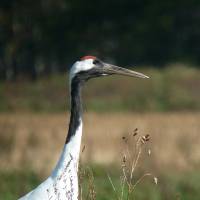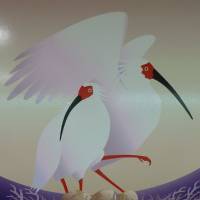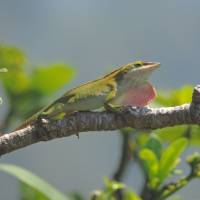Oriental stork 73; crested ibis 82; red-crowned crane 1,143; short-tailed albatross estimated 3,550. Those numbers of wild birds in Japan seem perilously low — and they are, especially when considered alongside the Japanese population of 126.75 million people — but in reality they are good news!
Each of those four large and long-lived avian species was considered extinct at some point in the 20th century. Each of those four species is actually on the long, slow road to recovery from a perilously close brush with termination. This is a "bad news/good news" story.
That each species nearly disappeared last century is entirely due to human activities such as hunting, habitat loss or habitat degradation, intensified farming and excessive use of agricultural chemicals. That each species is on the up-and-up this century is also the result of human activities — intensive conservation undertakings — combined with the natural resilience of individual wild creatures driven to survive and reproduce. Each of those species occurs in East Asia and nowhere else on Earth, and all of them are living on islands here in Japan.
Long isolated island nations such as New Zealand, Japan, Indonesia and Madagascar support tremendous biodiversity with extraordinary degrees of endemism. Endemic species are the truly unique ones found only on those isolated islands and nowhere else, and include species in every group of organisms you can possibly imagine, from non-flowering and flowering plants to fish, fungi, birds, insects and mammals. Just last month on Mount Chibusa, Haha-jima, in the Ogasawara Island group, I was introduced to a tiny, jewel-like creature: an almost entirely transparent snail. That species is just one of approximately 100 species of snail endemic to the subtropical forest on that mountain alone — and the peak is only 462.6 meters high!
Alas, that same isolation, over the eons of the evolutionary time scale, has rendered island species — whether endemic or not, such as the Oriental stork, crested ibis, red-crowned crane and short-tailed albatross, and that extraordinary see-through snail — uniquely vulnerable to environmental perturbations. They are especially susceptible to those conditions thrust upon them by unruly humanity: climate change, habitat destruction, habitat degradation and fragmentation, and the introduction of alien competitors and predators such as rats, cats, goats, acacia trees, cane toads, mosquitoes, longhorn beetles, fungi and fish, to mention a mere handful of the species that we humans have transported to out-of-the-way places.
The list of the top 100 invasive species and their impacts makes for depressing reading, but can be found here in all its gory detail: www.issg.org/database/species/search.asp?st=100ss. That shortlist of 100 species is just a selection of the worst offenders on the very much longer invasive species roster.
Isolated oceanic islands, such as the Ogasawara (or Bonin) Islands, are so far removed from the nearest mainland that few species are capable of reaching them naturally. The species that do make it to such places typically spread and diversify, but may only represent certain lifestyles — there may be no mammals or no woodpeckers, for example, on such isolated snippets of land, and no snakes or amphibians either. When we humans provide assisted passage, deliberately or accidentally, to species that have not previously reached such islands, we frequently unleash an apocalypse on the unsuspecting indigenous inhabitants.
Witness the small Asian mongoose introduced to Okinawa in 1910, which now threatens all of the native birds and mammals already there. Likewise the brown tree snake that has similarly devastated the native fauna of Guam since it was introduced there in 1950, and the green anole lizard introduced to the Ogasawara Islands in the 1970s and now wreaking havoc there.
It is for fear of the untold impact of such introduced exotic species that island countries such as New Zealand have become hyper-sensitive to biosecurity. After all, the introduction of a single disease organism can potentially wreak havoc on agriculture or on human health, while the arrival of a single rodent species can spell doom for native seed plants, insects and birds.
It should all be painfully obvious that preventing the arrival of unwanted species is crucial in all countries, and not just in island nations. But how do we respond when the latest cartoon show renders yet another species popular in the international pet trade, as was the case before the release of unwanted pet North American raccoons into the wild in Hokkaido in the 1970s following the success of anime series "Araiguma Rascal" ("Rascal the Racoon").
Japan, although very late to embrace the issue of biosecurity, is now making sterling attempts to reduce, control and prevent further damage by introduced alien species. Just in the last year I have come face to face with hard-working mongoose-busters on both Okinawa and Amami islands attempting to reduce that species' impact on native frogs, reptiles and birds, and hunters active in removing the vegetation-destroying feral goats and the all-consuming feral cats that became established on the Ogasawara Islands.
Environmental management today is a complex field requiring public understanding of the fact that on the one hand certain indigenous and endemic species are so endangered that they require conservation management to help their populations recover, whereas on the other hand certain native species have become so common that there is a clamoring for their population control. In between these two extremes are the out-of-control introduced exotic species causing so much environmental harm.
It has been reported (The Japan Times, March 26, 2014, "Eased hunting law eyed to cull deer") that increasing indigenous wild boar and Japanese deer are a threat to agricultural livelihoods and must be controlled. In fact, the government considers that their numbers should be halved over the next decade, according to the article. Yet with an aging and shrinking cohort of hunters that has dropped from about 530,000 in 1975 to just 190,000 in 2010, and with more than 60 percent of the latter number over 60 years of age, how can that reduction possibly be achieved, especially during the ongoing period of rural depopulation? There is a certain sense of unreality when the goal and the means are so far removed.
Even harder at times is explaining to the general public why hunting one species may be good and hunting another bad. It is not about the emotional attachment to the rights and wrongs of hunting, or about the emotive significance of the species being discussed, nor whether it is a "cute" introduced raccoon or a "scary" lizard, but it is all about understanding the negative impact that the species in question is having on the ecosystem and whether that particular species occurred there naturally or not and whether its numbers are in natural balance with its environment. Conservation management is certainly an uphill battle, but it is one vitally important in the fight to maintain the functioning ecosystems that we all depend on.
The Japanese government is, seemingly, also hell-bent on supporting an aging and globally unpopular whaling industry at the expense of garnering international disapprobation, when it could be gaining worldwide approval for supporting the fledgling whale-watching industry. So not surprisingly the international media frequently raises the red flag and focuses on Japan Inc.'s bad environmental track record, such as whaling and over-fishing, whenever it turns its attention to the environment here.
Therefore, not so much as an attempt to redress that balance, but as a means of opening a window for some fresh air, I would like to raise a green flag on behalf of the country that has had undeniable major conservation successes with several flagship species. Long live the Oriental stork, crested ibis, red-crowned crane, short-tailed albatross — and all those working to help them.
Mark Brazil has written "Wild Watch" for more than 30 years. He also organizes and leads wildlife, birding and photographic excursions around Japan. His latest book, "The Nature of Japan: From Dancing Cranes to Flying Fish," is available from www.japannatureguides.com or from the Junkudo Ikebukuro bookshop in Tokyo.





